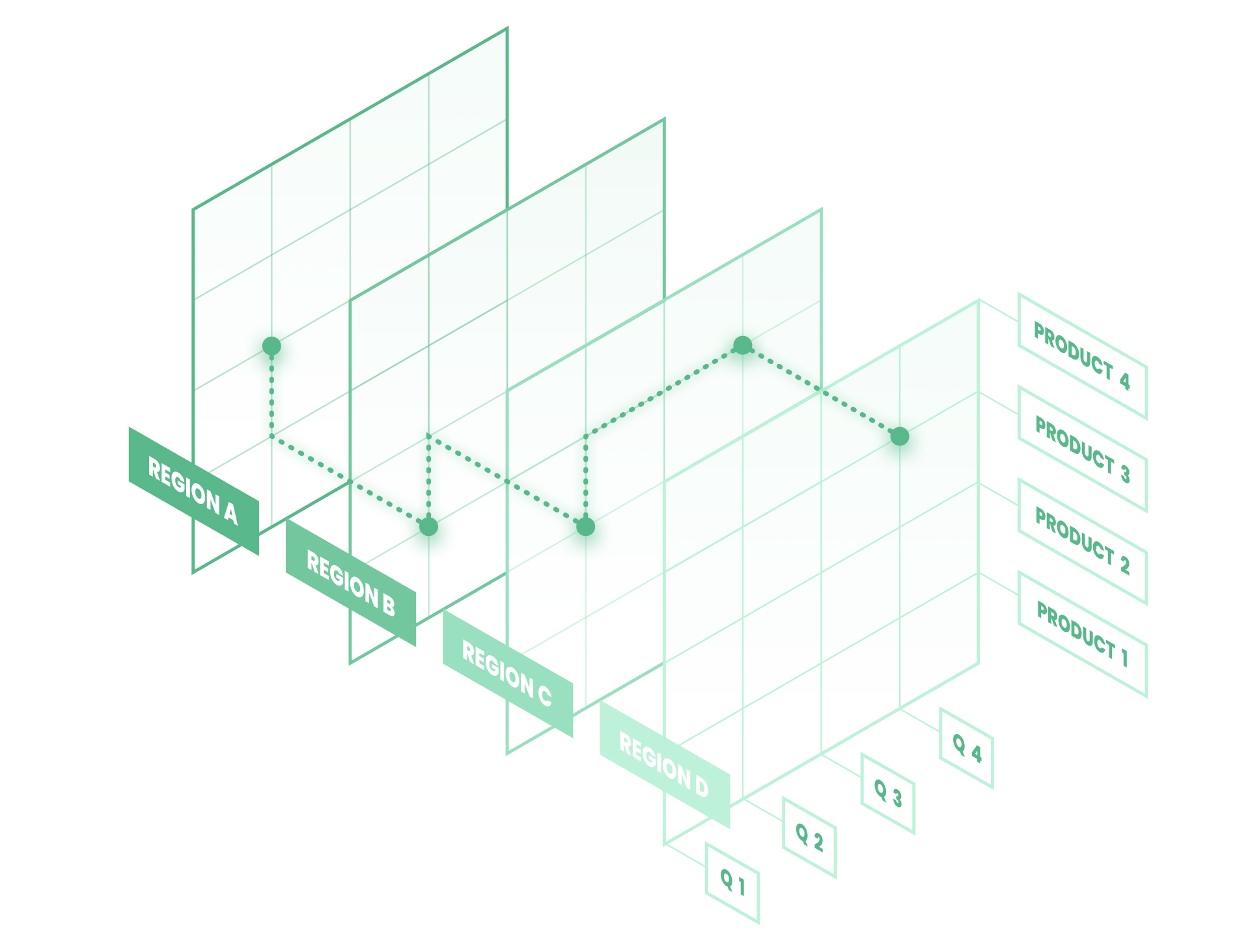Traditional retail models have been undergoing digital transformation. E-commerce trends incentivize retail businesses to act more proactively deliver a great customer experience and boost sales profits. For those businesses that overcame the challenge of the digital shift and now luckily apply data analytics and business intelligence solutions across their touchpoints, values are enormous.
With new technology trends evolving every day, customer demand is also shifting. That means you need to keep pace with a fast-tacking business environment and be focused on data-driven business decisions. For this purpose, retail business intelligence (BI), big data, and analytics are leveraged to enable retailers to optimize their product offerings and get closer to their customers delivering more personalized experiences to them. It is not new that brick-and-mortar retailers stay afloat, and to survive and thrive, they need more advanced digital approaches in their strategies in today’s retail ecosystem.
According to a MarketsandMarkets report, the global business intelligence market is anticipated to reach $33.3 billion by 2025.
How Retail Businesses Can Benefit From BI
Business Intelligence (BI) denotes an approach leveraging tools and services that are able to transform multiple data sets into actionable and valuable insights that businesses can use for their strategic business decisions. Data-driven decision-making drives marketing and product solutions, as well as customer loyalty. To get value out of a large amount of raw data it is not sufficient to capture and analyze it – this is a profound process of extracting and filtering that data to achieve structured, precise, and meaningful data through using sales automation tools, chatbots, dashboards, reporting, etc.
The purpose of e-commerce intelligence is to generate a variety of business decisions ranging from operational to strategic ones. The key to better business performance and profit growth is meeting customers’ expectations and needs, putting their personalized experience on a new level. For example, in order to understand their customers’ journey, retailers can use BI tools to track and monitor people in real-time and make smart and efficient decisions based on the data analyzed. Using IoT technologies, retail businesses are able to collect and process in-store data to get such insights as what zones are the most popular, what are customers’ behaviors, how to improve their experiences, etc.
Having access to real-time sales and operational data, companies can transform their reporting processes and automate them. For instance, Coca-Cola deployed the BI platform to maximize its operational efficiency by automating reporting processes and viewing them on dashboards just in a few clicks. Such a solution helps consolidate data from different sources and make it more granular. Now, automated reporting helps save up to 40 hours per week of manual work, which streamlines processes and fosters long-term decision-making rather than focusing on repetitive tasks. From the perspective of the user, the company applies consumer business intelligence backed by AI-powered image recognition technology to identify who, why, and where makes photos with their beverages. The technology helps make more personalized offers and advertising campaigns.
When you have access to real-time data and can structure it properly, you get more opportunities to adjust and optimize your pricing. With e-commerce business intelligence, your data is analyzed at a granular level which means you are equipped with accurate pricing models across different marketing touchpoints.
Business Intelligence vs Business Analytics
With the diversity in trends and new concepts, you may be wondering what the difference is between business intelligence for e-commerce and e-commerce data analytics. Since these two concepts are interchangeable, it is worth defining each to know how to apply them in your business strategy.
Business intelligence is geared toward making decisions on the basis of historical and present data using descriptive analytics, while business analytics helps anticipate future trends and outcomes. Business analytics uses predictive analysis (answering the question: What could happen in the future?) and prescriptive analytics (answering the question: What should we do to make better decisions?) and is an umbrella term for data analytics.

One more distinction between these terms is that business intelligence for e-commerce aims to provide data that is easily interpretable to business managers who are not technical people. On the contrary, e-commerce data analytics, with its predictions and the process of data mining, retrieving, and processing needs professional analysts who can dive into data and get the most value out of it.
How Can Retail Industry Use Business Intelligence: Key BI Functions
It is important to know that not always adopting new technologies and approaches is worth your time and budget. The first step toward adopting BI in your strategy – you have to define the problems e-commerce intelligence can help to cope with. Let’s overview the main functions of retail business intelligence to be aware of how you can apply it.
- Reporting. It is a process of retrieving and analyzing data from multiple data sources and as a result, obtaining meaningful insights to improve current business performance. Data pulled from different tools and platforms (CRM, ERP systems, HR management systems, finance systems, etc.) can help track tailored KPIs and measure sales, revenue, inventory expenditures, purchase orders, and much more. This data is consolidated in one automated database where employees can benefit from a holistic view of all analytics to make advanced forecasts and decisions. The main goal of reporting is to substitute data silos with a unified source of information providing people in the company with more accuracy, efficient time spending, and optimized workflows.
- OLAP Cube (Online Analytics Processing). To perform online analytical processing, companies require software that can analyze multidimensional and huge data sets from centralized databases quickly. When we talk about multidimensional data we mean that data is divided into multiple categories, for example, presentation, tracking, and analysis. These categories have several other dimensions. For instance, products can relate to clothing (men/women), then sub-dimension —> type and brand, size, etc. To explain concisely the specifics of online analytics processing, let’s compare it with a traditional relational database geared at storing records in a row-by-column table. When data volumes increase, the performance of their processing takes much more time and effort to properly reorganize the results. To resolve such inefficiencies, OLAP cube comes into play allowing to expand the table (spreadsheet) by adding additional layers. For example, among real-life solutions is IBM Db2 Warehouse on Cloud enabling online analytics processing. Actually, this is how IBM demonstrates OLAP Cube.

- Data mining. It is the process of extracting raw data from various sources and analyzing it to detect consistent patterns and then be able to further apply them to new data subsets. The data mining process undergoes the following steps:
- Extract, Transform, and Load (ETL) – data is extracted from multiple databases and converted into a standardized format.
- Data management – then data is stored in multidimensional databases (OLAP cubes).
- Data analysis – with software, data is analyzed and structured to be presented in an understandable format to the end-user.
- Dashboards. With customized metrics tailored to each business, data is visualized in the dashboards where employees can track key performance indicators on conversion, customer retention, inventory management, month/year revenues, etc. in real-time which makes business operations more efficient and streamlined.
- Predictive analytics. The principle of this BI tool is almost the same as with data mining: data is analyzed based on the existing data sets to generate insights. However, there is one difference: with predictive analytics, businesses can anticipate and project future scenarios about outcomes. Predictive analytics is based on identifying patterns to prevent inevitable circumstances and risks that can ruin business performance. Usually, it is interconnected with machine learning algorithms, AI, IoT, and other data-driven technologies. For the retail industry, predictive analytics plays an essential role in sales forecasting, logistics and store operations, price formation, inventory management, and market analysis. For instance, Airbnb applies predictive analytics patterns to suggest landlords set the most appropriate price for them. One more big player on the market, AmazonGo, also uses AI and predictive analytics to estimate when the stock needs to be replenished.
3 Benefits of Business Intelligence Systems in Retail
Track and Analyze Customer Behaviours
The major part of e-commerce intelligence is geared at enhancing customer experiences by tracking their journeys and behaviors both in physical stores and during their online presence. Backed by machine learning algorithms and IoT in-store systems, retail business intelligence is a powerful tool for building closer interactions with the customers and meeting their specific needs.
In terms of e-commerce, businesses can enhance their cross-selling and up-selling opportunities by tracking a user’s browser and purchasing history, and overall shopping habits which help them deliver highly personalized content. To proceed with online marketing, retail businesses are equipped with advanced solutions to facilitate brick-and-mortar stores’ experiences as well. For example, data obtained from RFID sensors or beacons can be used to deliver customers upfront special offers. Based on the browsing history, customers can be hooked at the right moment and get customized offers once they move near the store, for example.
A premier omnichannel retailer, Macy’s, is a great example of how personalization impacts customer loyalty and retention. By collecting and analyzing customers’ behavior patterns such as the frequency of their visits, their tastes, and preferences, Macy’s incentivizes them with customized loyalty programs and special offers. They anticipate their revenue to reach $10B from digital channels by 2023.
Get a Complete View of Business Operations
With retail business intelligence systems, there is no need to manually prepare reports and track business performance. Having access to real-time data, retail managers get the complete picture of all supply chain processes starting from under-performing inventory to out-of-stock products. In order to reduce drops in price, and ensure inventory effectiveness, and overall supply chain functioning, e-commerce intelligence can be applied through each step of supply chain management.
Having access to real-time data, businesses are equipped with tools allowing them to be informed about the business performance all the time which in turn impacts accurate forecasts and greater business planning efficiency.
Improve Your Marketing Efforts
Efficiently applying business-intelligent solutions in marketing will help you allocate your marketing budgets to the most successful campaigns that provide the best return on investment. Targeting the right audience is the number one challenge for marketing teams. BI can significantly help in collecting demographic information from multiple online platforms to further provide a holistic view of customers’ buying patterns, age groups, preferences, etc.
Traditional business reports with their disparate data formats make marketers’ efforts slow and inefficient. Reinforced by business intelligence, companies can significantly reduce report generation time from days to hours which in turn has an impact on customer retention rate. For example, the online gaming platform NetBet shifted its marketing strategy by implementing BI; therefore, the disparate data sets were unified into one format which allowed them to reduce time to hours while collecting and generating reports. In such a way, they optimized their efforts which led to the retention of their customers.
How to Successfully Implement BI
Once you decide to implement e-commerce business intelligence into your strategy, you need to elaborate upon your plan of action. We briefly outlined the main questions and recommendations on how to proceed with your road map.
- What’s your objective? Clearly defined problems with SMART goals will help you estimate the expectations and understand the result you would like to achieve.
- What do you already have? By collecting your current data you will be able to know what types of data and systems you have and how they can be used for further implementation of BI software. Therefore, it is important to consolidate the existing data and analyze it.
- What do you need to achieve your goal? To set realistic expectations, you should know what type of software you need, whether you want to integrate all your existing systems or replace them with cloud-based solutions, etc.
Once you answered these questions, you can move to the following steps of BI implementation:
- Establish KPIs. Key performance indicators, including financial metrics, customer service metrics, marketing metrics, human resources metrics, etc. play an essential role in achieving your goals aiming at evaluating the effectiveness and success of your planning.
- Educate your personnel. Without experience with BI, your company can take risks. Therefore, it is of high priority to inform your employees about the benefits of business analytics and business intelligence solutions in retail as well as to determine the stakeholders in each department.
- Select your software vendor. The selection of the software depends on your budget and your specific needs. To identify the best business intelligence software for your business you should evaluate the features it offers and how you can apply them within your current infrastructure. Oracle, IBM, SAP, and Tableau are among the best players in the market.
- Choose your data environment and BI platform. You can select on-premise, cloud-based, or hybrid solutions. Amazon Web Services, Microsoft Azure, and Google Cloud are the ones with the acknowledged platforms.
This list is not a finalized one, we just shed light on the main steps toward the successful launch of your BI project. The selection of the data environment and the best platform is important to understand how it will change your application architecture. For this purpose, hiring a skilled software developers team will not only help to set up a business intelligence solution but also will maintain and support you on each step of your new project journey.

Our Engineers
Can Help
Are you ready to discover all benefits of running a business in the digital era?

Our Engineers
Can Help
Are you ready to discover all benefits of running a business in the digital era?








